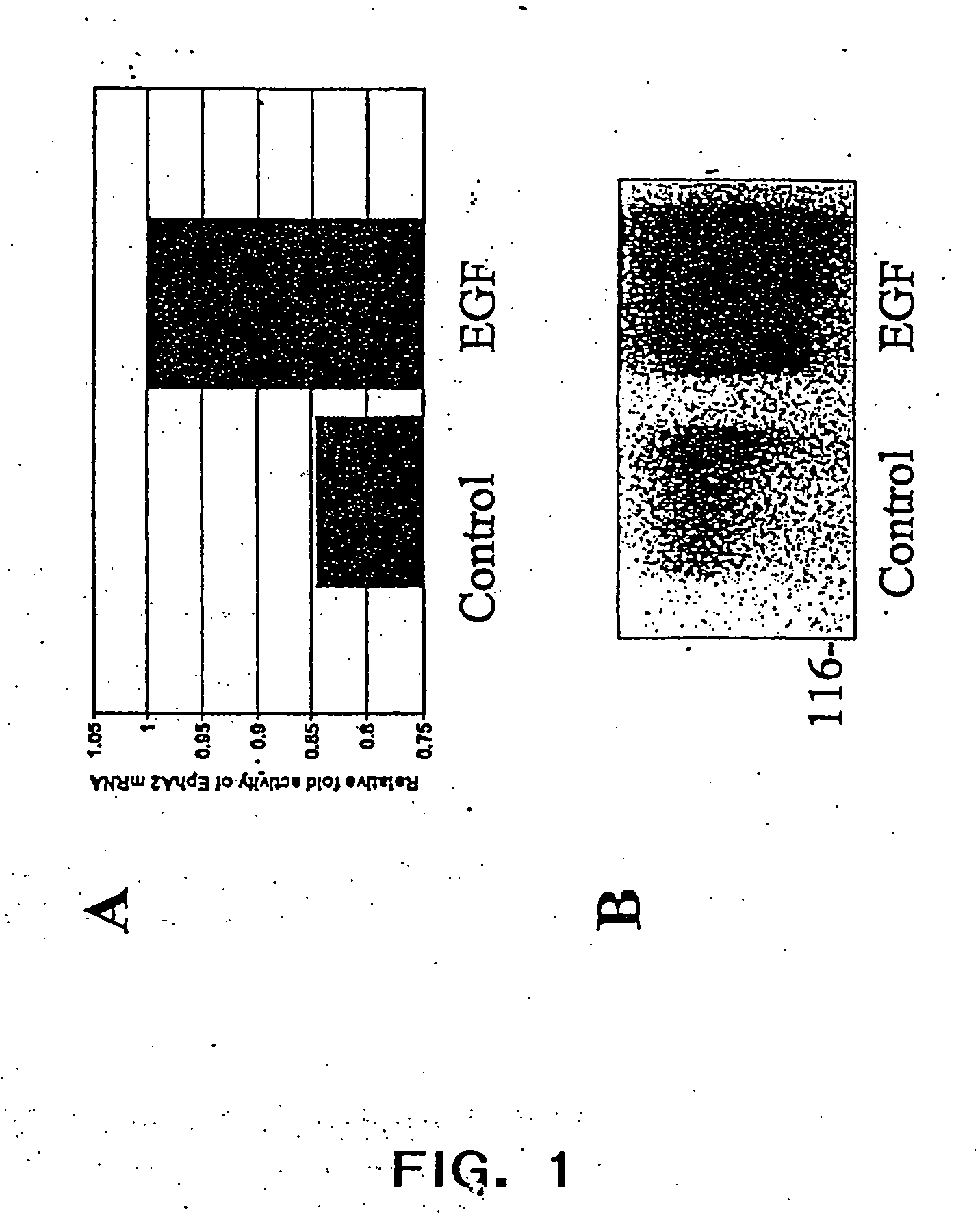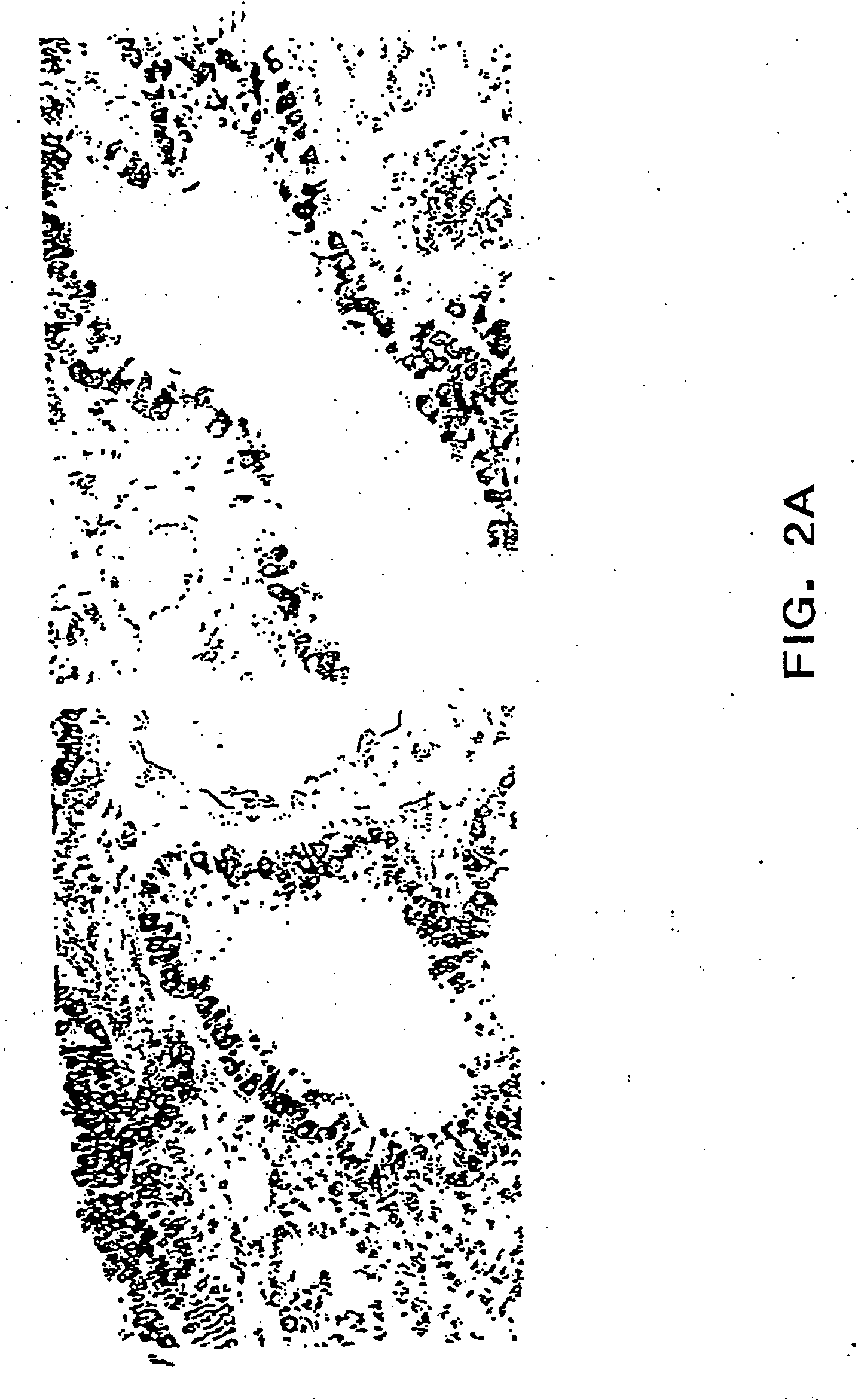[0032] The present inventors have found that EGF causes an increase in EphA2 expression at the level of both
protein and
mRNA expression. Without being bound by a particular mechanism, the direct effect of EGF-stimulated EphA2 expression, and thus increased EphA2 activity, may be responsible for the phenotypic changes in epithelial and endothelial cells in the presence of EGF.
[0034] In addition, hyperproliferating cells or excessive cell accumulation in a subject suffering from a non-neoplastic hyperproliferative cell or excessive cell accumulation disorder exhibit phenotypic traits that differ from those of cells in a unaffected subject. For example, in hyperproliferative epithelial cell respiratory disorders, EphA2-expressing non-neoplastic
airway epithelial cells from affected subjects demonstrate increased
mucin secretion, increased differentiation into a
mucin-
secreting cell (e.g.,
goblet cell), increased
secretion of
inflammatory factors, as well as hyperproliferation or excessive cell accumulation. In other hyperproliferative endothelial or epithelial cell disorders, EphA2-expressing endothelial or epithelial cells from affected subjects demonstrate increased
cell migration, increased
cell volume, increased
secretion of
extracellular matrix molecules (e.g., collagens, proteoglycans,
fibronectin, etc.), increased secretion of matrix metalloproteinases (e.g., gelatinases, collagenases, and stromelysins) and / or hyperproliferation.
[0042] In another embodiment, to identify a pathology-causing cell
phenotype inhibiting EphA2 agonistic agent, candidate agents may be screened for the ability to prevent or reduce secretion of
mucin, differentiation of an epithelial cell into a mucin-
secreting cell, secretion of
inflammatory factors, non-neoplastic hyperproliferation, non-
neoplastic cell migration, increased
cell volume, and / or secretion of
extracellular matrix molecules or matrix metalloproteinases.
[0060] As used herein, the term "pathology-causing cell
phenotype" refers to a function that a hyperproliferating cell performs that causes or contributes to the
pathological state of a hyperproliferative disorder.
Pathology-causing epithelial cell phenotypes include secretion of mucin, differentiation into a mucin-
secreting cell, secretion of
inflammatory factors, and hyperproliferation.
Pathology-causing endothelial cell phenotypes include increased
cell migration (not including
metastasis), increased
cell volume, secretion of
extracellular matrix molecules (e.g., collagen,
fibronectin, proteoglycans, etc.) or matrix metalloproteinases (e.g., gelatinases, collagenases, and stromelysins), and hyperproliferation. One or more of these pathology-causing cell phenotypes causes or contributes to symptoms in a patient suffering from a hyperproliferative cell or excessive cell accumulation disorder.
[0073] As used herein, a "therapeutically effective amount" refers to that amount of the therapeutic agent sufficient to treat or manage a disorder associated with EphA2 overexpression and / or hyperproliferation and, preferably, the amount sufficient to eliminate, modify, or control symptoms associated with such a disorder. A therapeutically effective amount may refer to the amount of therapeutic agent sufficient to
delay or minimize the onset of the hyperproliferative cell or excessive cell accumulation disorder. A therapeutically effective amount may also refer to the amount of the therapeutic agent that provides a therapeutic benefit in the treatment or management of a hyperproliferative cell or excessive cell accumulation disorder. Further, a therapeutically effective amount with respect to a therapeutic agent of the invention means that amount of therapeutic agent alone, or in combination with other therapies, that provides a therapeutic benefit in the treatment or management of a hyperproliferative cell or excessive cell accumulation disorder. Used in connection with an amount of an EphA2 agonistic agent of the invention, the term can encompass an amount that improves overall therapy, reduces or avoids unwanted effects, or enhances the therapeutic
efficacy of or synergies with another therapeutic agent.
 Login to View More
Login to View More 


